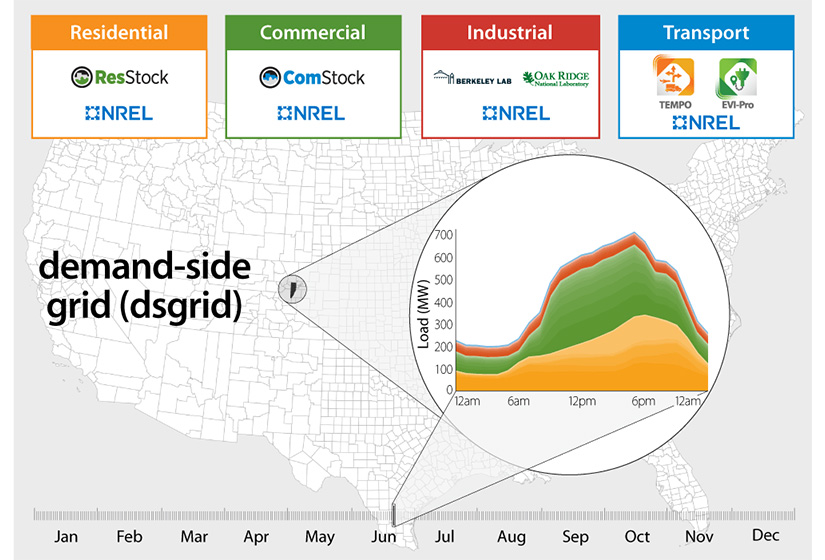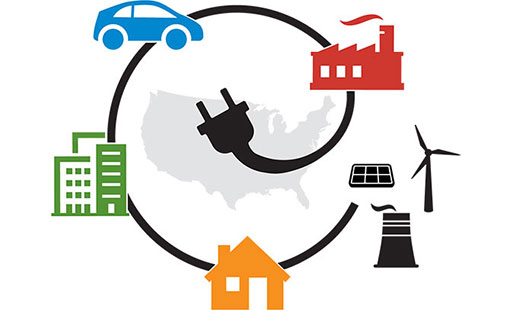dsgrid: Demand-Side Grid Toolkit

NREL's demand-side grid (dsgrid) toolkit harnesses decades of sector-specific energy modeling expertise to understand current and future U.S. electricity load for power systems analyses.
The primary purpose of dsgrid is to create comprehensive electricity load data sets at high temporal, geographic, sectoral, and end-use resolution. These data sets enable detailed analyses of current patterns and future projections of end-use loads.
Electricity Load Modeling

Electrical load forecasting has been at the heart of utility planning for decades, but typical top-down approaches do not provide the granularity in time, geography, end use, and technology that is needed to explore the potential impact of technological shifts. For example, many studies of future grid systems employ relatively simple scaling of historical loads, placing more emphasis on supply-side resources such as generation and transmission that are fewer in number and are better understood in terms of cost and performance as compared to demand-side resources.
The dsgrid platform fills these gaps with a bottom-up methodology that allows analysis of "what if" scenarios of future electricity load. It leverages multiple detailed sectoral energy models to provide hourly time series of load by subsector, end use, and U.S. county. Each dsgrid data set typically covers a full year, which either represents a historical year or a future model-year scenario.
Although dsgrid currently emphasizes electricity load data, its component sector models and methods for residential buildings, commercial buildings, and industry provide information on other fuel use, including natural gas. The data sets can be leveraged to support analysis of numerous demand-side technology-driven changes, such as energy efficiency, electrification, and operational flexibility (i.e., demand response). The electricity use data are time-synchronized with solar and wind data sets and are thus suitable for use in power systems analysis.
Residential Sector
ResStock™ is a physics-based simulation model developed to represent the energy use and energy saving potential of residential building stocks with high granularity at national, regional, and local scales. ResStock is a U.S. Department of Energy (DOE) model that has been developed and maintained by NREL since 2014. It takes a new approach to large-scale residential energy analysis by combining large public and private data sources, statistical sampling, detailed subhourly building simulations, and high-performance computing.
Commercial Sector
ComStock™ is a DOE model of the U.S. commercial building stock, developed and maintained by NREL. The model takes some building characteristics from the DOE's Commercial Prototype Building Models and Commercial Reference Buildings. However, unlike many other building stock models, ComStock also combines these with a variety of additional public- and private-sector data sets. Collectively, this information provides high-fidelity building stock representation with a realistic diversity of building characteristics.
Transportation Sector
TEMPO™ is an NREL model used to explore transportation pathway options to produce long-term scenarios that reach strategic transportation-energy-environment objectives and assess synergies with energy supply. TEMPO is used to project mobility demand for passenger and freight, mode choices, technology adoption and ultimately energy use and emissions, including annual hourly charging load profiles within each county. TEMPO is currently used in dsgrid to project county-level hourly load profiles associated with personal light-duty electric vehicle charging.
With increasing adoption of electric vehicles (EVs), the future grid can benefit from EV managed charging. NREL’s study on the value of EV managed charging uses detailed simulation modeling to evaluate how managed charging can reduce the costs of integrating EVs into an envisioned future bulk power system. The study uses dsgrid-flex, a software package for translating device-level information into accurate, megawatt-scale models of aggregated distributed energy resource flexibility, to transform vehicle-level load profiles into grid model-ready, battery-like flexibility resources.
Industrial Sector
NREL is currently working to understand how industry may evolve to use more renewable energy, electrify, and otherwise decarbonize. NREL has also partnered with Oak Ridge National Laboratory and the Electric Power Research Institute to model industrial energy use with the Industrial Geospatial Analysis Tool for Energy Evaluation for the Electrification Futures Study. These efforts have focused on first improving the geographic, operational, and temporal detail of industrial energy data.
NREL researchers have piloted three new methods for exploring and classifying the energy characteristics of industrial processes. First, the dsgrid industrial energy modeling team have validated an innovative method to estimate industrial energy demands at the facility level using public greenhouse gas reporting. Second, machine learning was applied to data reported from the U.S. Department of Energy's Industrial Assessment Center program, finding clusters of small- to medium-sized industries to aid accurate estimates of electricity use. Third, modelers adapted cladistics—an evolutionary classification system developed in biology—to energy modeling. This approach was applied to the evolution of the iron and steel sector, classifying different emerging technologies into a tree diagram—or cladogram—to show how the sector is changing to meet the decarbonization challenge. More information on these methodologies and their potential applications to industrial energy modeling can be found in the NREL report, Exploring New Ways to Classify Industries for Energy Analysis and Modeling, linked in the Publications section below.
Explore NREL's other efforts on industrial energy data improvements via the analysis done for the Solar for Industrial Process Heat project and NREL's United States county-level industrial energy use data.
dsgrid-Supported Studies
Electrification Futures Study
The Electrification Futures Study (EFS) was a multi-year research project that explored the impacts of widespread electrification on all U.S. economic sectors. The dsgrid toolkit was developed for the EFS and used to produce hourly electricity consumption profiles for every county in the contiguous United States for historical year 2012. The initial modeling methods and results are publicly available and described in the dsgrid toolkit documentation and on the EFS website.
Los Angeles 100% Renewable Energy Study
A city-scale version of dsgrid was developed for NREL’s groundbreaking Los Angeles 100% Renewable Energy Study (LA100). LA100 involved a series of integrated modeling activities to explore pathways to the nation’s second-largest city could take to achieve their goal of a 100% clean energy future. The dsgrid toolkit was used to inform bulk power system modeling, customer adoption of distributed PV and storage, distribution system modeling, and air quality modeling. More information can be found in the executive summary of the final LA100 report, chapter 3: electricity demand projections, and chapter 12: synthesis.
Open-Source API Access
The dsgrid data produced for the EFS is available via the NREL Open Energy Data Initiative (OEDI) in an HDF5 format. The open source Python API is available through Github and PyPI. Example Jupyter notebooks demonstrate how to access, summarize, and visualize the data on OEDI using the API.
Get the dsgrid-legacy-efs-api for browsing and analyzing the EFS data files:
PyPI.
Get the dsgrid EFS data files:
The dsgrid team is developing a new, flexible data format and Python API, which were designed in response to lessons learned during dsgrid's first two projects. A formal package release and accompanying new, national-scale dataset (alpha versions) are expected by Winter 2023.
Keep up with the development of the new dsgrid data format and API:
Publications
Highly Resolved Projections of Passenger Electric Vehicle Charging Loads for the Contiguous United States, NREL Technical Report (2023)
Exploring New Ways To Classify Industries for Energy Analysis and Modeling, NREL Technical Report (2022) and United States Census Working Paper (2022)
One of These Things IS Like the Other: Pursuing a New Taxonomy of Industry for Improved Energy System Modeling, Proceedings of the ACEEE 2021 Summer Study on Energy Efficiency in Industry Virtual (2021)
Executive Summary in The Los Angeles 100% Renewable Energy Study, NREL Technical Report (2021)
Chapter 3: Electricity Demand Projects in The Los Angeles 100% Renewable Energy Study, NREL Technical Report (2021)
Chapter 12: Synthesis in The Los Angeles 100% Renewable Energy Study, NREL Technical Report (2021)
Using Facility-Level Emissions Data To Estimate the Technical Potential of Alternative Thermal Sources To Meet Industrial Heat Demand, Applied Energy (2019)
Industrial Energy Data Book, Department of Energy Technical Report (2018)
The Demand-Side Grid (dsgrid) Model Documentation, NREL Technical Report (2018)
Generation and Use of Thermal Energy in the U.S. Industrial Sector and Opportunities To Reduce Its Carbon Emissions, NREL Technical Report (2016)
Your personal data will not be shared and will be used only to manage your subscription for as long as you are subscribed. For more information, review the NREL security and privacy policy.
Contact
Share


